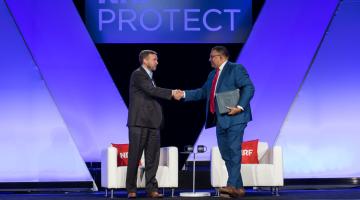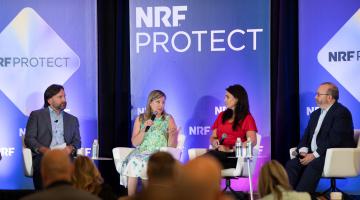
In a session at NRF PROTECT, James Densley, professor of criminal justice at Metro State University, and Jillian Peterson, a forensic psychologist and professor of criminology at Hamline University, presented “The Violence Project: How to Stop a Mass Shooting Epidemic.”
The Violence Project is essentially a research idea that grew; Professors Densley and Peterson have published a number of its main findings as a book. It is also the largest database on mass shootings in the United States, which — given that the incidence of these events is significantly higher than anywhere else — means it is also the largest database on mass shootings in the world.
The researchers have interviewed all surviving mass shooters, along with relatives, survivors, law enforcement officials and others. The subject is of particular interest to the retail industry, whose leaders are actively seeking to protect employees, customers and community members from attacks like the recent mass shooting in a supermarket in Buffalo, N.Y.
Did you miss NRF PROTECT 2022? Take a look at our event recap.
The purpose of the project is to find a way to stop a mass shooting from taking place. Mass shootings, defined as firearms attacks in which at least four people are killed, have become increasingly common: according to Violence Project statistics, 40 percent of all those on record have taken place during the last decade.
There are some commonalities among the perpetrators: of the 172 mass shooters studied, only four were women; in two cases, the woman acted in partnership with a man. Average age at the time of the attack was about 35. While the stereotype multiple killer is a white man, white people account for only 52 percent of mass shooters.
The most common background trait of mass shooters is a criminal record, at 65 percent , closely followed by a history of violence at 63 percent. Employment troubles (51%), a history of trauma (42%) and domestic abuse (36%) are other common traits.
Of the mass killers studied, 80 percent had had a crisis of some sort before the shooting, and at least a third of them were suicidal. (It seems likely, the professors hinted, that the urge to suicide is a major factor in more cases than that. The career of a mass shooter can end in only one of three ways: they shoot themselves, they’re killed by a law enforcement officer or they spend the rest of their lives in prison.)
Browse resources and read the latest articles and press releases related to loss prevention.
Collecting data on mass shootings is one thing; doing anything about them — as the researchers freely admitted — is something else. There is, however, reason to hope. Dr. Peterson began her career working as a special investigator in New York City, researching the life histories of men facing the death penalty at their sentencing hearings — not a background designed to produce chirpy optimists. “The worse the crime,” she said, “the worse the story.”
Still, she sees possibilities. Before he murdered nine people at a Black church in South Carolina, Dylann Roof had been repeatedly banned from the mall where he liked to hang out. The perpetrator of the recent supermarket massacre in Buffalo had gone back to the store three times before he finally came in shooting. “Suppose they had been greeted by someone who said to them, ‘What brings you here today,’” Peterson said. “Would it have mattered?”
Is it possible for people in an industry with a stake in this problem to connect with someone who might be headed down a path to violence in time to make a difference?
The session ended with no clear answer, but with a sense that there might be. It was at least a start on good news.


